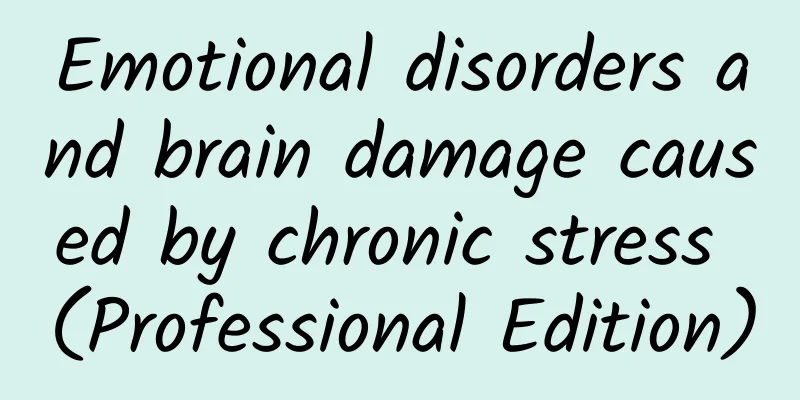Emotional disorders and brain damage caused by chronic stress (Professional Edition)

|
introduction: How does stress cause people to suffer from emotional disorders such as anxiety, depression, bipolar disorder and obesity when facing a high-pressure society, work and family? Why do childhood psychological trauma and negative stimulation from the original family affect one's life? How to deal with a relationship and marriage that makes you stressed? How to get out of these shadows? This article opens up another perspective from the perspective of cognitive neuroscience - the negative effects of stress and stress hormones on the brain, which can cause brain damage and cognitive impairment in some cases, and how to look at getting out of stress, depression and other problems from a professional perspective. Living organisms must adapt to changes in the environment and maintain their integrity in order to survive. Young organisms must complete this process through changes and development. In the face of stressors or homeostatic threats in the external environment, individuals maintain their integrity by changing themselves. This change involves the whole body's response to time, memory, and the transfer of energy and resources to promote survival in the present, often at the expense of inhibiting growth and repair. Therefore, the systems responsible for adapting to stress are intertwined with those responsible for growth and development, and understanding these systems and their functions is very important for our understanding of the developmental process. The HPA system is often referred to as the stress system. Although the HPA system is primarily involved in stress responses, its influence is very extensive. In non-stressful situations, when this system maintains the basic functions of the internal environment, its active role is to support growth and development. In challenging environments, the activity of the HPA system is enhanced, and hormones and peptides are released, which inhibit growth and repair processes and instead help the organism maintain the functions necessary for survival in the present to cope with stress and challenges. Stress and challenges can cause increased HPA activity. There are two types of stressors that individuals face, namely physiological stressors and psychological stressors. Physiological stressors such as blue light stimulation, hypoxia, and physiological trauma involve the brainstem system and do not require cognitive processing. Psychological stressors such as control constraints, fear conditioning, or exposure to novel environments, accusations, abuse, rule oppression, and psychological manipulation require the participation of high-level cognitive processing. Unlike physiological stress, psychological stress does not involve a threat to physiological homeostasis. Perhaps we can understand that the brain's response to psychological stress is to define it as an anticipation of future physiological threats. Physiological stress and psychological stress involve different neural circuits, among which psychological stress mainly involves the circuits of the limbic system. 1. Neurobiological basis of the HPA system The central nervous system is responsible for coordinating the endocrine system's response to threats and challenges. Input from the limbic system enables cognitive-emotional challenges to activate the HPA axis. Stress and challenge signals first activate the central hypothalamic paraventricular nucleus, which then stimulates the release of CRH (corticotropin-releasing hormone). CRH, together with other secretagogues such as vasopressin, stimulates the pituitary gland to synthesize and release ACTH (adrenocorticotropic hormone), which then reaches the adrenal glands through the circulatory system. At this time, the adrenal medulla secretes adrenaline, while the adrenal cortex secretes glucocorticoids. For humans, the dominant glucocorticoid is cortisol. Glucocorticoids are inertly bound to globulins, which allows them to be stored in this bound form for rapid release at any time. This may explain the mechanism by which short-term rest does not reduce stress. Cortisol affects almost all organs and tissues in the body, including energy mobilization and immunosuppressive effects. Cortisol can easily pass the blood-brain barrier, and cortisol receptors are distributed throughout the central nervous system. In other words, the central nervous system is particularly sensitive to cortisol and affects the nervous system in many ways. 1. HPA system activities The HPA system mainly responds to psychological stressors through the limbic system, which includes the amygdala and the amygdala peripheral system. When the limbic system is damaged, the rise of cortisol is suppressed when facing psychological stimuli, but these areas do not affect the rise of cortisol levels when stimulated by physiological stressors, such as illness and trauma. The connection between the limbic system and the HPA system is called LHPA. But it is particularly important that CRH is produced in other areas of the brain in addition to the hypothalamus. There are a large number of neurons in the amygdala that can produce CRH, and CRH greatly increases the level of glucocorticoids in this area, and behaviors related to fear and anxiety also increase. This is an important reminder-stress can cause emotional reactions, and emotional reactions ultimately increase cortisol levels. Increased cortisol then stimulates the amygdala to form positive feedback to stimulate HPA to produce cortisol. Therefore, when the negative feedback mechanism mentioned later is complete, emotional control is particularly important for depression and anxiety. Thinking is to load cognitive burden, and cognitive burden will increase stress. Therefore, for anxiety and depression, stopping useless thinking and emotional control are particularly important for LHPA regulation. 2. Regulation of glucocorticoids: the role of receptors The HPA axis regulates glucocorticoid levels through a negative feedback loop. The feedback points for glucocorticoids are the pituitary gland, hypothalamus, hippocampus, and frontal cortex. Elevated glucocorticoids inhibit CRH production in the paraventricular nucleus of the hypothalamus. And negative feedback is provided under stress and baseline conditions to two receptors in the pituitary gland and hippocampus: the mineralocorticoid receptor and the glucocorticoid receptor. Both are involved in the stress response, and both are necessary, although the mineralocorticoid receptor is more closely linked. But the distribution of these receptors in the human brain remains unknown, with the human frontal cortex more strongly associated with negative feedback, a mechanism that holds back glucocorticoid responses to stressors. 3. Baseline activity of the LHPA axis and development of the LHPA axis The LHPA system shows circadian variation. Baseline levels of glucocorticoid production peak upon waking and reach a low point at the onset of sleep. This variation is related to the need to mobilize energy at the beginning of the day. Newborns show steadily increasing glucocorticoid levels in response to stressful events, but reactivity decreases significantly between 2 and 4 months of age. Another stage of significant decline in glucocorticoid response is between 6 and 12 months of age, when infants of this age no longer show elevated glucocorticoid levels in response to milder stressors when cared for by their parents. II. Early Experience and the LHPA Axis The process of brain growth and development involves the interaction of the organism with a complex and challenging environment. Neurobiological systems responsible for emotion processing are plastic and can therefore be altered by experience. These systems are particularly susceptible to shaping early in life, when connections in the limbic system are still developing. In experimental animals, daily manipulations such as petting or personal isolation can permanently alter their responses to stress, fear behaviors, and cognitive functions. The effects of these early experiences are achieved in part through a negative feedback process that is mediated by changes in the number of glucocorticoid receptors. The researchers found that the mother-infant interactive LHPA axis is an important mediator of the development. The manipulation of enhanced maternal care reduced the reactivity of individuals to psychological stressors in adulthood (as reflected by reduced glucocorticoid and ATCH levels). This suggests that individuals who receive better care in childhood can show stronger and more flexible stress tolerance in the future. Although animals with enhanced maternal attention did not show differences in baseline levels of related hormones, they showed reduced fear responses in novel environments and reduced LHPA responses to multiple stressors, accompanied by rapid termination of glucocorticoid responses, which represents a very effective negative feedback system. Animals that had this experience had more mineralocorticoid receptors and glucocorticoid receptors in their hippocampus and frontal cortex. However, the manipulation of interrupting parental care had the opposite effect, producing offspring that were called hyperresponsive, with lower levels of glucocorticoid receptors and a poorly regulated LHPA system. Early deprivation experiments also used non-human primates as research subjects (the earliest deprivation experiments were Watson's intimidation experiment and the mother deprivation experiment, which represented behavioral psychology). Infants raised in a social stimulus deprivation environment often showed enhanced fear behavior. Monkeys raised by peers rather than by their mothers showed more shyness, low dominance, and fear of new opposite sexes. They also showed higher LHPA responses when facing stress. Milder severance of the mother-infant relationship can also affect the LHPA system. There are very few studies that explore the relationship between human early experience and LHPA axis activity. Children raised in Romanian orphanages did not have the glucocorticoid circadian rhythm seen in normal children. Moreover, children who were adopted after 8 months had higher levels of glucocorticoids during the day, and the longer they stayed in the orphanage, the higher the level of glucocorticoids. Children with post-traumatic stress disorder (PTSD) show similar long-term effects on glucocorticoid levels after years of abuse. These children show multi-level dysregulation of the LHPA axis, including elevated baseline glucocorticoid levels. Adult women who experienced sexual abuse in childhood show greater CRH elevations in response to a stressor. These results should be interpreted with caution, as the findings do not report much about the development of the HPA system in individuals within the normal range of experience. In the study of LHPA in non-extreme parenting conditions, the differences caused by different parenting styles in natural situations were examined. Insecure attachment relationships are characterized by insensitive and unstable caregiving behaviors. Compared with children with secure attachment relationships, children with insecure attachment relationships are more likely to show elevated glucocorticoid levels when faced with a range of potentially threatening stimuli, including vaccinations, parent-child separation, and novel times. These data suggest that the activity of the LHPA system can be influenced by maternal care. However, the role the child plays can also have an impact on the development of a secure relationship. Although little is known about how experience alters late LHPA axis activity in humans, several mechanisms have been proposed, such as changes in limbic system circuits involved in regulating LHPA and changes in the number of mineralocorticoid and glucocorticoid receptors. 3. LHPA axis and cognitive memory impairment 1. Dose-effect relationship of glucocorticoids on hippocampal neuronal damage The hippocampus plays an important role in multiple cognitive processes, including learning and memory. Changes in hippocampal activity caused by sustained high glucocorticoid levels may lead to cognitive deficits. The relationship between glucocorticoids and hippocampal performance is not a linear relationship, but an inverted U-shaped relationship, that is, moderate levels of glucocorticoids are optimal for hippocampal performance, while extremely low and high levels of glucocorticoids reduce the activity of hippocampal neurons. The regulation of hippocampal neuron activity affects the long-term potentiation of synapses. LTP refers to a long-lasting increase in synaptic efficiency. This enhancement occurs when receiving high-frequency electrical stimulation, and this process is considered to be necessary for the learning process. Evidence shows that glucocorticoids regulate LTP by similar mechanisms. Extremely high or low levels of glucocorticoids inhibit long-term extension, while moderate levels of glucocorticoids promote long-term extension. This suggests that the best learning state is neither under high stress levels nor under extreme relaxation, but under moderate stress. Glucocorticoids do not only affect neural activity, there is evidence that sustained and extremely high glucocorticoid levels can lead to degeneration of hippocampal neurons. In addition, chronic, high levels of glucocorticoids not only damage neurons, but also affect the ability of individuals to survive other unexpected challenges. Evidence suggests that high levels of excitatory amino acids such as glutamate activate NMDA receptors, which is a major factor in hippocampal atrophy. The release of excitatory amino acids is regulated in part by glucocorticoids. Elevated glucocorticoid levels under chronic stress produce prolonged increases in glutamate levels, which can lead to sustained activation of NMDA receptors and potential cell death. Glucocorticoids inhibit glucose transport in the brain, resulting in energy deficiency that makes it difficult for the hippocampus to sustain normal activity. This energy deficiency may be a major mechanism by which glucocorticoids cause hippocampal damage. Hippocampal atrophy caused by chronically elevated glucocorticoid levels is associated with memory deficits. This inverted U-shaped dose-response curve is caused by changes in the occupancy of mineralocorticoid and glucocorticoid receptors, because mineralocorticoid receptor binding increases hippocampal excitability, while glucocorticoid receptor binding has the opposite effect. Glucocorticoids may impair cognitive function in humans, and acute administration of glucocorticoids has been associated with impairments in hippocampal-dependent memory systems. Furthermore, exogenous glucocorticoid administration at levels similar to psychophysiological stress inhibits verbal declarative memory function in adults. These data suggest that impairments in human memory performance can occur in response to acute or prolonged stress, ranging from mild to severe stress. 2. Damage of the prefrontal cortex by glucocorticoids Evidence suggests that glucocorticoids are involved in executive functions of the frontal cortex. Elevated glucocorticoid levels may affect neural systems related to attention. Elevated glucocorticoid levels are associated with frontal cortical dysfunction, such as attention deficits, and interfere with frontal lobe functions such as planning, attention regulation, and working memory. Animal experiments have shown that chronic increases in glucocorticoid levels may lead to degeneration of frontal cortical nerves, and high levels of glucocorticoids lead to high levels of extracellular excitatory amino acids, which can cause potential damage. Although evidence suggests that elevated glucocorticoids affect the function of the frontal cortex, it is also possible that individual differences in the prefrontal cortex affect the activity of the LHPA system. For example, stress may cause difficulty planning, which in turn activates the LHPA system, creating a stress-increasing cycle. Many studies examining the effects of glucocorticoids on cognition have involved acute administration of glucocorticoids to adults, but for children, the effects of early adversity on cognition may be minimal in early childhood, but small differences can set children on a developmental trajectory that leads to significant functional impairment later in life. 4. Positive feedback between LHPA axis and anxiety and fear Emotion researchers have long used glucocorticoids as a marker of individual differences in negative emotions (such as fear and anxiety). Because LHPA axis activity is associated with the fear system, and the amygdala itself secretes CRH and accumulates high levels of glucocorticoids in emotional states, individuals with the most significant increase in glucocorticoids will show the strongest panic or anxiety response when faced with threatening events. However, there have been many contradictory research results, raising questions about whether glucocorticoid activity can be directly linked to negative emotions. It is inappropriate to view elevated glucocorticoid levels as a maladaptive response. There is a dynamic relationship between glucocorticoids and the neural systems involved in emotional processing. Amygdala and LHPA axis LHPA axis activity in response to psychological stressors is regulated by the limbic system, and LHPA also regulates emotional processing in the limbic system. The amygdala is considered to be a central brain structure for fear-induced sensory, automatic inputs, and behavioral outputs. CRH in the amygdala plays an important role in enhancing LHPA axis activity and mediating the amygdala's response to fear. Studies have found that negative life events that increase glucocorticoids can also affect CRH levels in the hypothalamus and amygdala. Glucocorticoid receptors (positive feedback) have been found in the cell bodies of the amygdala that produce CRH. Among them, the CRH1 receptor is the main receptor for glucocorticoids, which regulates the production of anxiety. CRH1 receptors are widely distributed in the monkey brain, especially in the limbic system, and the expression of CRH receptors shows a high degree of plasticity. Animal experiments have shown that a variety of different stressor stimuli can lead to an increase in the RNA of CRH1 receptors in the rat brain. In addition, rhesus monkeys deprived of maternal care have more CRH1 receptor expression in the hippocampus and frontal cortex. This upward regulation can enhance fear responses or lower fear thresholds. Therefore, the interaction between glucocorticoids and the CRH system is a potential mechanism through which stressful environments may affect an individual's responsiveness to future stressful events. Startle reaction experiments have shown that CRH in the amygdala, glucocorticoids in the circulatory system, and chronic glucocorticoid elevations can all enhance the startle reflex of CRH-induced animals. The activity of these systems may affect the development of pathological anxiety. Individual differences in general levels of fear and anxiety may be related to the excitability of the amygdala or the bed nucleus of the stria terminalis, and the differences may be due to different levels of CRH. Chronic and repeated stressful experiences may affect the fear circuit and cause long-term changes in these circuits. These changes will then lower the threshold of fear-inducing stimuli. Leading to potential anxiety. Patients with PTSD show higher baseline levels of CRH compared to healthy people. Studies support the view that the amygdala-LHPA axis is involved in enhancing the sensitivity of individuals to emotional feelings. 5. LHPA axis and brain development Researchers tried to explore the relationship between LHPA activity and fear and anxiety in developing individuals. In group studies, when events were threatening, glucocorticoids increased significantly. This is considered a normal fear regulation response, and the increase in glucocorticoids may enable individuals to better face fearful events. The researchers also examined the relationship between individual personality and glucocorticoids, and there was evidence that monkeys that displayed avoidance, shyness, freezing, and fear had higher baseline glucocorticoid levels; individuals with greater emotional responses to threats and psychological challenges also showed higher glucocorticoid levels. The results of anxiety behavior and glucocorticoids are similar to those found in human children, where elevated baseline glucocorticoid levels in children are associated with increased behavioral inhibition. However, the above research is not absolutely true. Children may adopt protective strategies, that is, individuals with extroverted behavior will regulate their behavior in new and strange environments by increasing cortisol, while shy and anxious children may develop coping strategies to help them maintain lower cortisol levels when entering into crowd challenges. Adjustability of attentional control in anxiety and depression How people process events can also influence the association between glucocorticoid production and fear and anxiety. For example, whether people pay attention to information determines their emotional and behavioral responses to situations. Children who are able to shift their attention away from threatening stimuli and inhibit reflexive responses may successfully use this strategy to reduce their anxiety. This individual difference is sometimes considered a form of proactive behavioral control, representing a form of attention that allows people to autonomously regulate their behavior. Individuals who are better able to regulate their attention are also less sensitive to stimuli that trigger fear, anxiety, and depression. Among individuals, those who need to exert effort to control their attention and disengage from unpleasant events show higher cortisol levels and lower thresholds for stimulation than those who are better able to regulate their attention. In addition to attention regulation, environmental context is also a mediating variable. Active individuals initially showed high cortisol levels in a novel environment, and showed lower glucocorticoid reactivity after adapting to the environment, but children who were not well integrated and had negative emotions showed high levels of glucocorticoid reactivity. These evidences suggest that novel environmental stimuli are associated with increased glucocorticoid levels, and threatening novel conflicts are often associated with increased LHPA activity. Although repeated exposure to stressful situations usually reduces the cortisol response, there are situations where this adaptation does not occur. When individuals are exposed to repeated and persistent stressful situations, over time, instead of showing a decrease in cortisol levels when they continue to face stress, their LHPA system becomes sensitive to this situation. This change can increase an individual's risk for developing developmental affective disorders - PTSD, anxiety disorders, depression, bipolar disorder, etc. Systemic disorders caused by adversity will cause excess glucocorticoids in the circulation system, which may be a potential factor in changing the brain circuits of fear, anxiety, and depression. CRH receptors in the amygdala, frontal cortex, etc. are triggered by high levels of cortisol to trigger positive feedback. The increased CRH levels may cause the amygdala to be oversensitive, increasing the risk of anxiety disorders. In a system with normal regulatory ability, this high level of glucocorticoids will normally reduce the release of glucocorticoids to baseline levels through a negative feedback system. However, in a disordered system, chronic high levels of cortisol will downregulate the receptors involved in this negative feedback process. This may impair the system's automatic stress shutdown ability, resulting in a continuous high level of cortisol hormone circulation. The continued existence of this process will cause glucocorticoid-related pathological states. Researchers on affective disorders have found that girls who have been sexually abused show low levels of ACTH, but their baseline levels of glucocorticoids are elevated. This is because if the pituitary gland shows a low response to excess CRH, the system will compensate for this low response by increasing CRH and cortisol. This study is consistent with the results of adult and child depression studies, and the feedback mechanism is dysregulated. Note: Effects of glucocorticoids on metabolism: (1) Increase liver glycogen and blood sugar by promoting gluconeogenesis, slowing down glucose decomposition, and reducing the body's use of glucose; (2) Improve protein catabolism, increase serum amino acids and urinary nitrogen excretion, and cause negative nitrogen balance. Large doses can also inhibit protein synthesis; (3) It can increase plasma cholesterol, activate subcutaneous esterase in the limbs, promote the decomposition of subcutaneous fat, and redistribute it to the face, upper chest, neck, back, abdomen and buttocks, forming centripetal obesity. |
Recommend
Can pregnant women eat pistachios?
What pregnant women eat has always been a questio...
Drink Chinese medicine for pregnancy promotion a few days after menstruation
The reason why some women are infertile is becaus...
What is the fetal development at 38 weeks of pregnancy?
As women become pregnant and their due date appro...
Is Changbai Mountain a historical and cultural heritage? When is the best time to visit Changbai Mountain?
From the foot to the top of the Changbai Mountain...
What foods can make your breasts bigger?
Women nowadays not only have high requirements fo...
Is it difficult to get pregnant if you have blood type O?
Blood type has a huge impact on people. Medically...
Blood clots in early pregnancy
Estrogen in the body is an important hormone that...
Can breast duct ectasia heal on its own?
There are many women who suffer from breast duct ...
How to improve egg quality at the age of 43
Generally speaking, as women age, the quality of ...
Can I have a blood test during my menstrual period?
During menstruation, women lose a lot of nutrient...
How to cook rice so that children will not be picky eaters? Try this trick now!
The Mid-Autumn Festival is coming soon. This year...
The effect of women drinking strong wine
China Jinjiu is a health-care wine with excellent...
Can I eat jelly during menstruation?
Every adult woman will experience menstruation. I...
What causes pain and itching below
If women have vulvar itching, they will be misera...
What are the benefits of taking a nap for girls
If girls take naps regularly, they can improve th...









